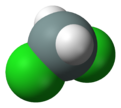- Dichlorosilane
-
Dichlorosilane 

 DichlorosilaneOther namesSilicic dichloride dihydride
DichlorosilaneOther namesSilicic dichloride dihydrideIdentifiers CAS number 4109-96-0 
PubChem 61330, 22967941 ((2H2)silane) ChemSpider 55266 
EC number 223-888-3 UN number 2189 RTECS number VV3050000 Jmol-3D images Image 1 - Cl[SiH2]Cl
Properties Molecular formula H2Cl2Si Molar mass 101.01 g mol−1 Exact mass 99.930282011 g mol-1 Appearance Colorless gas with characteristic odor Melting point -122 °C, 151 K, -188 °F
Boiling point 8 °C, 281 K, 46 °F
Solubility in water Reacts Vapor pressure 163.6 kPa (20 °C) Hazards MSDS ICSC 0442 EU Index Not listed Main hazards Extremely flammable gas, explosive in air NFPA 704 Flash point −28 °C Explosive limits 4.1–99% Related compounds Related chlorosilanes Chlorosilane
Trichlorosilane
Silicon tetrachlorideRelated compounds Difluorosilane
Dibromosilane
Dichloromethane (verify) (what is:
(verify) (what is:  /
/ ?)
?)
Except where noted otherwise, data are given for materials in their standard state (at 25 °C, 100 kPa)Infobox references Dichlorosilane (H2SiCl2), or DCS as it is commonly known, is usually mixed with ammonia (NH3) in LPCVD chambers to grow silicon nitride in semiconductor processing.
A higher concentration of DCS:NH3 (i.e. 16:1), usually results in lower stress nitride films.
It is an intermediate between silane and silicon tetrachloride.
External links
- Safety data for dichlorosilane from the Chemistry Department at Oxford University.
Categories:- Inorganic compound stubs
- Inorganic silicon compounds
- Silanes
Wikimedia Foundation. 2010.

